The Sun Sets on Sunshine: FAUST Writes Paean to NYC Streetscape
The five projectors at the Sunshine Cinema have gone dark as of January, and this month the 150+ year old building is scheduled to be razed for a 9 story office building. Because, you know, we need one. Graffiti writer FAUST just secured permission to say his own goodbye to the theater in a poetic way with his ornately scripted street style calligraphic hand, marking a sunset on Sunshine.
BSA is proud to debut FAUST’s own penned thoughts on this New York story of love and loss, of continuous building and destruction, of cultural touchstones that disappear seemingly overnight – usually so someone can make a buck. Herewith we present the words of FAUST for BSA readers with our thanks to him and to you.
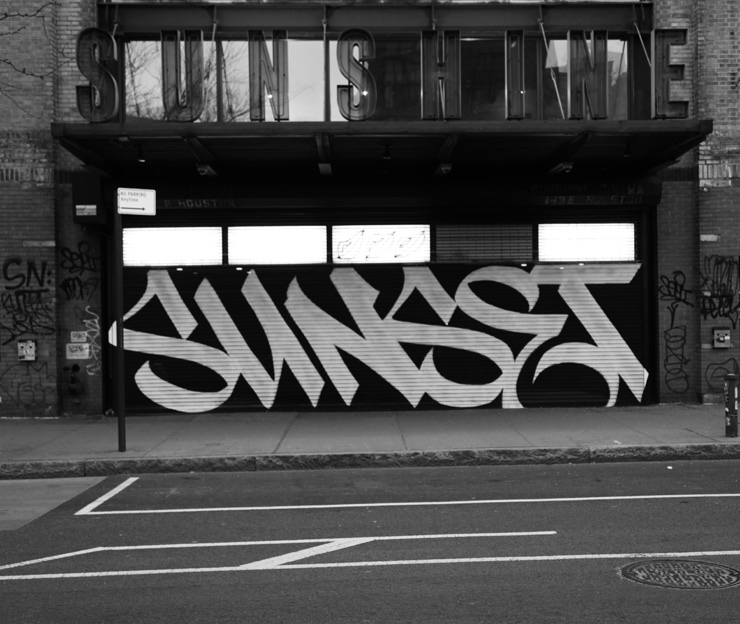
Faust. Sunset (photo © Jaime Rojo)
Every time I approach a new work, I try to find a word or phrase that would be clever, poignant, and site-specific. Oftentimes, that could take weeks of research and brainstorming, but on Houston Street that wasn’t the case. With so many memories inside of those walls, this mural on the shuttered facade of the Sunshine Cinema felt much more personal than most of my previous projects.
The first time I saw the gate down and learned of the theater’s demise, I instantly knew I wanted to paint it in homage to the historic site. And the following day it came to me, a poetic sendoff to both celebrate and mourn the final days of the Sunshine Cinema. Sunset.
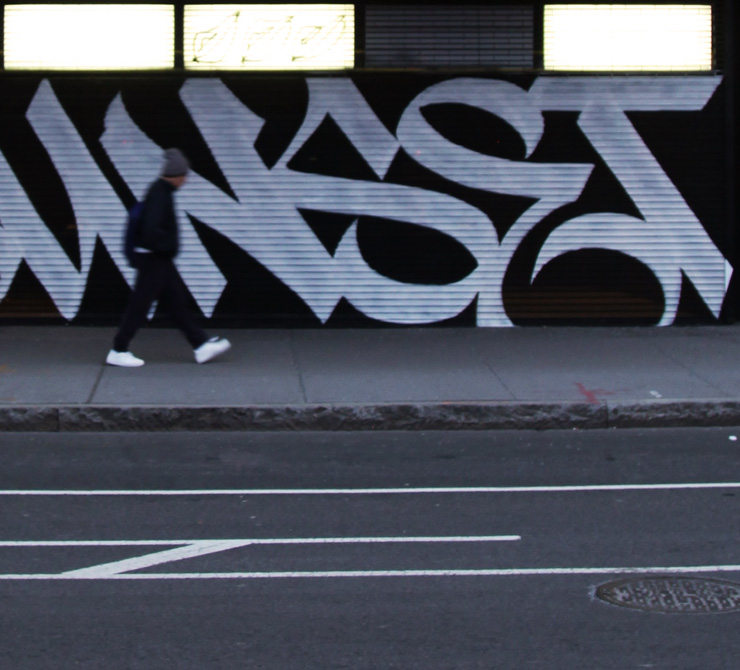
Faust. Sunset (photo © Jaime Rojo)
I confess, as a teenager I became well-acquainted with the back door to the Sunshine Cinema which granted me free access to other worlds on the big screen. Growing up in New York City, a significant part of my adolescence was spent at that Lower East Side movie theater which focused on independent and foreign films. I snuck into the critically-acclaimed 2002 Brazilian feature City of God so many times that I started to believe I knew Portuguese because I had memorized the subtitles.
But my favorite time to go to the Sunshine was for their midnight movie. Each weekend they screened a different cult classic on Friday and Saturday nights. I spent my 19th birthday catching a sold out screening of The Warriors, my first time seeing the 1979 film that depicts a New York that no longer exists – gritty, overrun by street gangs, and covered in graffiti.
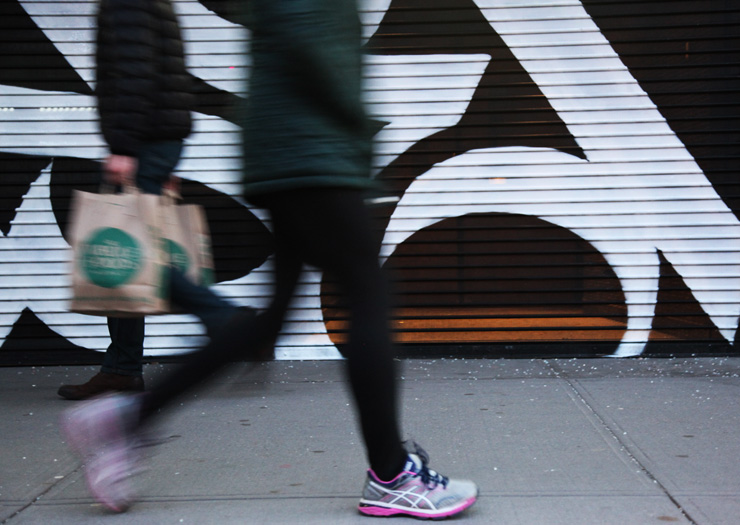
Faust. Sunset (photo © Jaime Rojo)
My career as an artist is deeply rooted in my upbringing as a graffiti writer. The style of my work derives from a contemporary history of writing on walls and subways that spans nearly 50-years. Anytime I paint abroad, I feel like a cultural ambassador bringing my distinctly “New York” aesthetic across the globe. But New York is always home–and always will be. At home the work takes on a different meaning; carrying on the tradition of a wide-spread (albeit illicit) art movement that has risen up from the streets and making a statement that hopefully resonates with my friends and neighbors who see it.
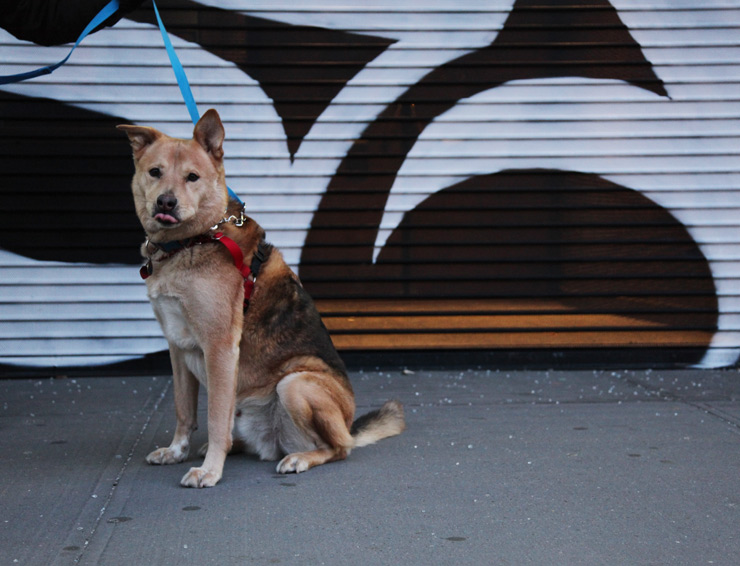
Faust. Sunset (photo © Jaime Rojo)
The 30,000 square-foot building on Houston Street has a long history of entertainment in the Lower East Side. Sections of the building date back to 1844, when it first opened as a church, before being converted into the Houston Athletic Club, a prize fight club, in the early 1900’s. Shortly after, the building was purchased and converted into the Houston Hippodrome, which offered moving picture shows and Yiddish vaudeville acts to the growing Jewish immigrant community in the neighborhood.
In 1917 the theater was converted into a nickelodeon and renamed the Sunshine Theater. The theater closed in 1945 and was used as storage up until the 1990s. For a brief period, from 1994 to 1998 the space was rented out for concerts and events before being leased to Landmark Theaters. After undergoing a $12 million renovation, the Sunshine Cinema as I know it opened on December 21, 2001.
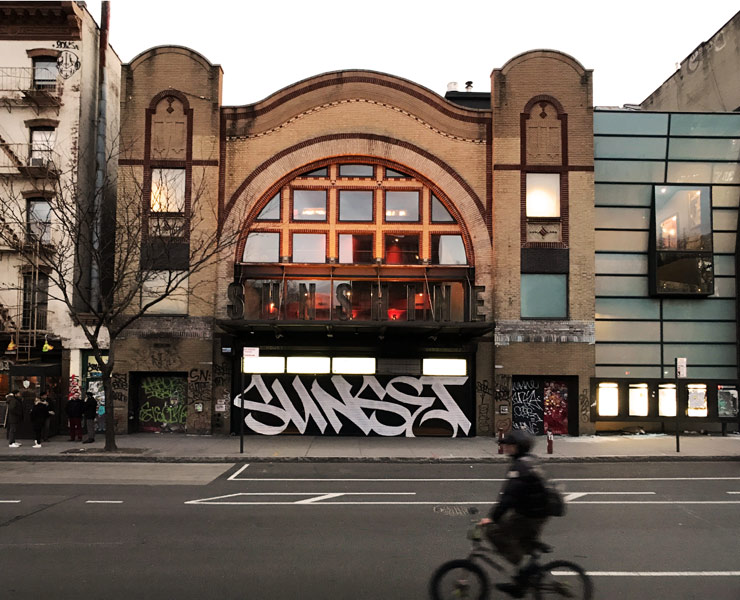
Faust. Sunset (photo © Jaime Rojo)
The Sunshine Cinema isn’t even the latest in a string of closures of historic NYC theaters including the Ziegfeld Theater in 2016 and Lincoln Plaza Cinemas which just closed it’s doors on January 31st. When these cultural institutions have no chance of keeping their heads above water in the current real estate market is it officially time to say New York is dead? As early as 1927 author H. P. Lovecraft had declared “New York is dead, & the brilliancy which so impresses one from outside is the phosphorescence of a maggoty corpse.” But we all know that couldn’t be further from the truth. Each successive generation inevitably breathes new life into the city and finds inspiration in the hallowed concrete jungle.
I discussed my idea for the mural with filmmaker Charlie Ahearn and described my dismay when I found out about the closure. I was surprised that he didn’t share my sentiment. Rather, he said he always thought of the Sunshine as a new theater. I suppose if I had lived though the New York art world of the 70s, 80s, and 90s as he had, I’d likely feel the same way. “Have you been to the Metrograph? Now that’s a great theater!” he told me about the new cinema that opened in the Lower East Side in 2016 and recently hosted a sold out screening of his cult classic film Wild Style.
It’s ingrained in us all as New Yorkers to gripe every time a local landmark shutters, be it a cultural institution in a historic building or a corner bodega that can no longer compete with the new Whole Foods that opened down the block. It’s part of our DNA to wax poetic about the New York City we grew up in, whichever era that was. But it’s safe to say that more prescient than the idea that New York is dead is another old adage; the only constant is change.
Other Articles You May Like from BSA:
BSA Images Of The Week: 06.12.22
Welcome to BSA Images of the Week!
There are always so many hype-dope-cool-rad-slaps things to do in New York period - and often plenty graffiti and street art options. There's the new Rememb...BSA Film Friday: 07.11.14
Our weekly focus on the moving image and art in the streets. And other oddities.
Now screening :
1. Auckland's Al Fresco Festival
2."Where The Food Grows" by Noah Throop
3. Herakut: ...Urku Abstractly / One Wall Project / Urban Nation Berlin
A fresh face at Urban Nation, the abstract muralist URKU has just completed the façade across the train tracks from the museum on Bulowstrasse.
Urku. One Wall Project. Urban Nation Berlin. Septe...Urban Nation Museum. Art Mile: Installations In Progress. Dispatch 5
Today some progress shots - these projects were not completed while we were shooting so you’ll want to go to the Museum Mile today along Bülowstraße (Berlin U-Bahn). The Urban Nation Art Mile (Artme...Edoardo Tresoldi: A Reprise of "Sacral" for Ravenna
“An archetypal image”, Edoardo Tresoldi says, “is capable of creating a dialogue between past and present, using a language comprised of meanings that recur over time.”
Edoardo Tresoldi. "Sacral"....
Other Articles You May Like from BSA:
Welcome to BSA Images of the Week! There are always so many hype-dope-cool-rad-slaps things to do in New York period - and often plenty graffiti and street art options. There's the new Rememb...
Our weekly focus on the moving image and art in the streets. And other oddities. Now screening : 1. Auckland's Al Fresco Festival 2."Where The Food Grows" by Noah Throop 3. Herakut: ...
A fresh face at Urban Nation, the abstract muralist URKU has just completed the façade across the train tracks from the museum on Bulowstrasse. Urku. One Wall Project. Urban Nation Berlin. Septe...
Today some progress shots - these projects were not completed while we were shooting so you’ll want to go to the Museum Mile today along Bülowstraße (Berlin U-Bahn). The Urban Nation Art Mile (Artme...
“An archetypal image”, Edoardo Tresoldi says, “is capable of creating a dialogue between past and present, using a language comprised of meanings that recur over time.” Edoardo Tresoldi. "Sacral"....
 BROOKLYN STREET ART LOVES YOU MORE EVERY DAY
BROOKLYN STREET ART LOVES YOU MORE EVERY DAY










